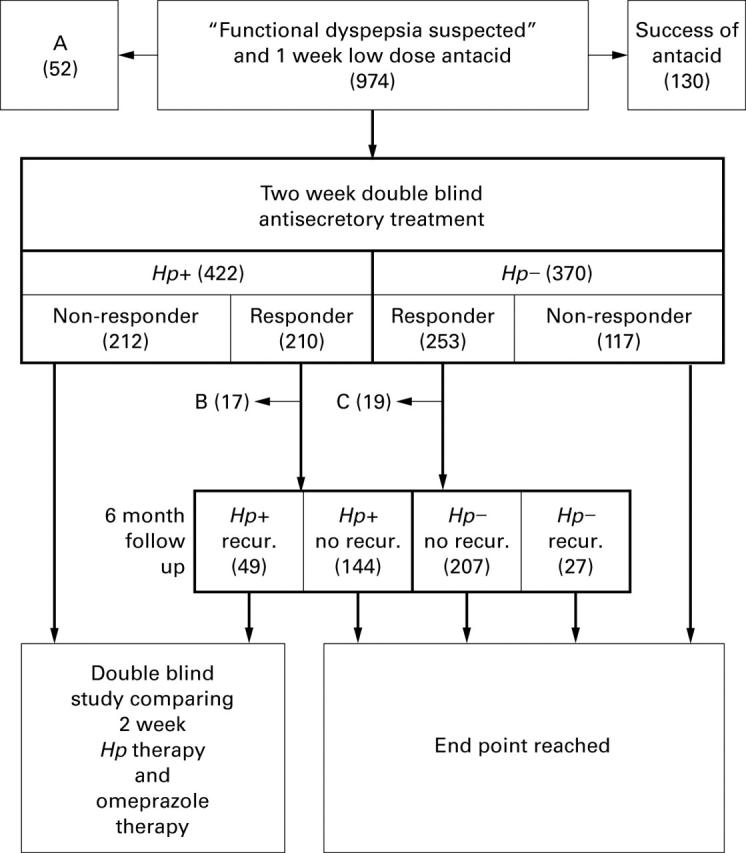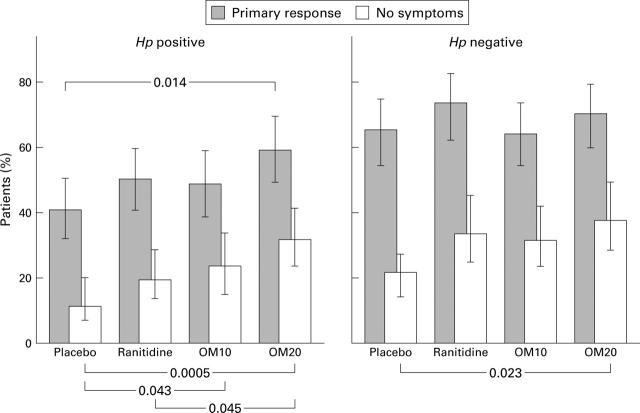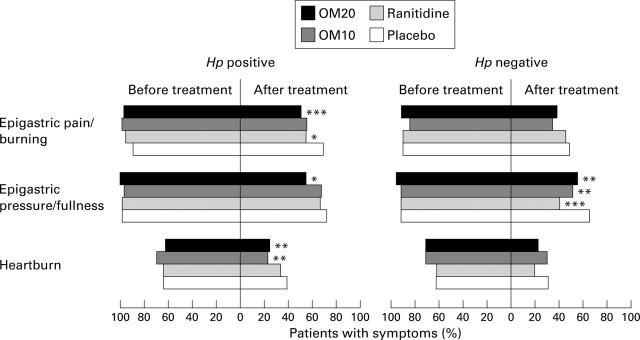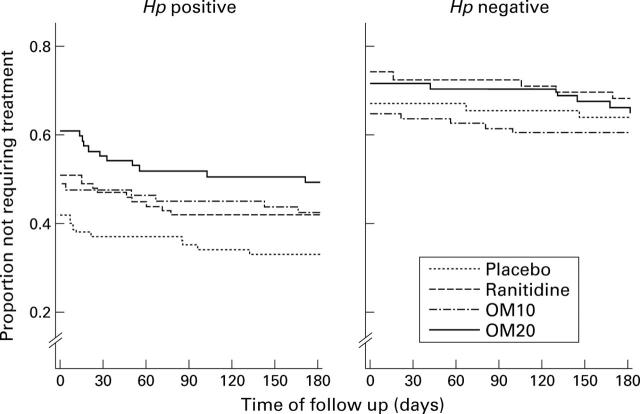Abstract
BACKGROUND AND AIMS—Treatment of functional dyspepsia with acid inhibitors is controversial and it is not known if the presence of Helicobacter pylori infection influences the response. METHODS—After a complete diagnostic workup, 792 patients with functional dyspepsia unresponsive to one week of low dose antacid treatment were randomised to two weeks of treatment with placebo, ranitidine 150 mg, omeprazole 10 mg, or omeprazole 20 mg daily. Individual dyspeptic and other abdominal symptoms were evaluated before and after treatment according to H pylori status. RESULTS—The proportions of patients considered to be in remission (intention to treat) at the end of treatment with placebo, ranitidine 150 mg, omeprazole 10 mg, and omeprazole 20 mg were, respectively, 42%, 50%, 48%, and 59% in the H pylori positive group and 66%, 73%, 64%, and 71% in the H pylori negative group. In H pylori positive patients, the therapeutic gain over placebo was significant for omeprazole 20 mg (17.6%, 95% confidence intervals (CI) 4.2-31.0; p<0.014 using the Bonferroni-adjusted p level of 0.017) but not for omeprazole 10 mg (6.8%, 95% CI −6.7-20.4) or ranitidine 150 mg (8.9%, 95% CI −4.2-21.9). There was no significant therapeutic gain from active treatment over placebo in H pylori negative patients. Complete disappearance of symptoms and improvement in quality of life also occurred most frequently with omeprazole 20 mg and was significant in both H pylori positive and H pylori negative groups. The six month relapse rate of symptoms requiring treatment was low (<20%) in all groups. CONCLUSIONS—Omeprazole 20 mg per day had a small but significant favourable effect on outcome in H pylori positive patients. The differential response in these patients may be explained by an enhanced antisecretory response in the presence of H pylori. The effect of weaker acid inhibition was unsatisfactory. Keywords: functional dyspepsia; omeprazole; ranitidine; Helicobacter pylori; randomised controlled trial; quality of life
Full Text
The Full Text of this article is available as a PDF (172.9 KB).
Figure 1 .

Flow chart of the 974 dyspeptic patients who entered the run in week with low dose antacid treatment. A=not randomized after run in period for reasons other than response to antacid treatment (n=52). B=H pylori positive responders not entering follow up (n=17). C=H pylori negative responders not entering follow up (n=19). Responder=no dyspeptic symptoms requiring further management after the two week double blind treatment (main outcome criterion). Hp, Helicobacter pylori; recur.,recurrence of dyspeptic symptoms requiring management
Figure 2 .
Effect of two week treatment with placebo, ranitidine, omeprazole 10 mg (OM10), or omeprazole 20 mg (OM20) on dyspeptic symptoms according to percentage of patients who became completely symptom free (no symptoms) and those with no need for further management (main outcome criterion) (means and 95% two sided confidence intervals; exact test). For assessment of significance levels, see text. The number of patients per group is given in table 1. Hp, Helicobacter pylori.
Figure 3 .
Effect of treatment with placebo, ranitidine, omeprazole 10 mg (OM10), or omeprazole 20 mg (OM20) on individual dyspeptic symptoms. The horizontal bars show the percentages of patients with each individual symptom before and after each two week double blind treatment. *p<0.05; **p<0.025, ***p<0.001 compared with placebo in the same Helicobacter pylori (HP) group.
Figure 4 .
Life table analysis of patients without sufficient symptoms to require specific active management after successful treatment in the four treatment groups (placebo, ranitidine, omeprazole 10 mg (OM10), or omeprazole 20 mg (OM20)). At time 0 the proportion of patients with successful two week treatment is given; these patients entered follow up. The number of patients per group is given in the text. Hp, Helicobacter pylori.
Selected References
These references are in PubMed. This may not be the complete list of references from this article.
- Agréus L., Talley N. J. Dyspepsia: current understanding and management. Annu Rev Med. 1998;49:475–493. doi: 10.1146/annurev.med.49.1.475. [DOI] [PubMed] [Google Scholar]
- Bennett E. J., Piesse C., Palmer K., Badcock C. A., Tennant C. C., Kellow J. E. Functional gastrointestinal disorders: psychological, social, and somatic features. Gut. 1998 Mar;42(3):414–420. doi: 10.1136/gut.42.3.414. [DOI] [PMC free article] [PubMed] [Google Scholar]
- Blum A. L., Talley N. J., O'Moráin C., van Zanten S. V., Labenz J., Stolte M., Louw J. A., Stubberöd A., Theodórs A., Sundin M. Lack of effect of treating Helicobacter pylori infection in patients with nonulcer dyspepsia. Omeprazole plus Clarithromycin and Amoxicillin Effect One Year after Treatment (OCAY) Study Group. N Engl J Med. 1998 Dec 24;339(26):1875–1881. doi: 10.1056/NEJM199812243392602. [DOI] [PubMed] [Google Scholar]
- Bytzer P., Hansen J. M., Schaffalitzky de Muckadell O. B. Empirical H2-blocker therapy or prompt endoscopy in management of dyspepsia. Lancet. 1994 Apr 2;343(8901):811–816. doi: 10.1016/s0140-6736(94)92023-0. [DOI] [PubMed] [Google Scholar]
- Eypasch E., Wood-Dauphinée S., Williams J. I., Ure B., Neugebauer E., Troidl H. Der Gastrointestinale Lebensqualitätsindex (GLQI). Ein klinimetrischer Index zur Befindlichkeitsmessung in der gastroenterologischen Chirurgie. Chirurg. 1993 Apr;64(4):264–274. [PubMed] [Google Scholar]
- Finney J. S., Kinnersley N., Hughes M., O'Bryan-Tear C. G., Lothian J. Meta-analysis of antisecretory and gastrokinetic compounds in functional dyspepsia. J Clin Gastroenterol. 1998 Jun;26(4):312–320. doi: 10.1097/00004836-199806000-00022. [DOI] [PubMed] [Google Scholar]
- Friedman L. S. Helicobacter pylori and nonulcer dyspepsia. N Engl J Med. 1998 Dec 24;339(26):1928–1930. doi: 10.1056/NEJM199812243392611. [DOI] [PubMed] [Google Scholar]
- Gillen D., Wirz A. A., Ardill J. E., McColl K. E. Rebound hypersecretion after omeprazole and its relation to on-treatment acid suppression and Helicobacter pylori status. Gastroenterology. 1999 Feb;116(2):239–247. doi: 10.1016/s0016-5085(99)70118-6. [DOI] [PubMed] [Google Scholar]
- Herschbach P., Henrich G., von Rad M. Psychological factors in functional gastrointestinal disorders: characteristics of the disorder or of the illness behavior? Psychosom Med. 1999 Mar-Apr;61(2):148–153. doi: 10.1097/00006842-199903000-00005. [DOI] [PubMed] [Google Scholar]
- Holtmann G., Talley N. J. Functional dyspepsia. Current treatment recommendations. Drugs. 1993 Jun;45(6):918–930. doi: 10.2165/00003495-199345060-00005. [DOI] [PubMed] [Google Scholar]
- Klauser A. G., Schindlbeck N. E., Müller-Lissner S. A. Symptoms in gastro-oesophageal reflux disease. Lancet. 1990 Jan 27;335(8683):205–208. doi: 10.1016/0140-6736(90)90287-f. [DOI] [PubMed] [Google Scholar]
- Klauser A. G., Voderholzer W. A., Knesewitsch P. A., Schindlbeck N. E., Müller-Lissner S. A. What is behind dyspepsia? Dig Dis Sci. 1993 Jan;38(1):147–154. doi: 10.1007/BF01296788. [DOI] [PubMed] [Google Scholar]
- Labenz J., Bärsch G., Peitz U., Aygen S., Hennemann O., Tillenburg B., Becker T., Stolte M. Validity of a novel biopsy urease test (HUT) and a simplified 13C-urea breath test for diagnosis of Helicobacter pylori infection and estimation of the severity of gastritis. Digestion. 1996 Nov-Dec;57(6):391–397. doi: 10.1159/000201366. [DOI] [PubMed] [Google Scholar]
- Lambert J. R., Midolo P. The actions of bismuth in the treatment of Helicobacter pylori infection. Aliment Pharmacol Ther. 1997 Apr;11 (Suppl 1):27–33. doi: 10.1046/j.1365-2036.11.s1.13.x. [DOI] [PubMed] [Google Scholar]
- Lind T., Havelund T., Carlsson R., Anker-Hansen O., Glise H., Hernqvist H., Junghard O., Lauritsen K., Lundell L., Pedersen S. A. Heartburn without oesophagitis: efficacy of omeprazole therapy and features determining therapeutic response. Scand J Gastroenterol. 1997 Oct;32(10):974–979. doi: 10.3109/00365529709011212. [DOI] [PubMed] [Google Scholar]
- Locke G. R., 3rd Prevalence, incidence and natural history of dyspepsia and functional dyspepsia. Baillieres Clin Gastroenterol. 1998 Sep;12(3):435–442. doi: 10.1016/s0950-3528(98)90016-1. [DOI] [PubMed] [Google Scholar]
- McColl K., Murray L., El-Omar E., Dickson A., El-Nujumi A., Wirz A., Kelman A., Penny C., Knill-Jones R., Hilditch T. Symptomatic benefit from eradicating Helicobacter pylori infection in patients with nonulcer dyspepsia. N Engl J Med. 1998 Dec 24;339(26):1869–1874. doi: 10.1056/NEJM199812243392601. [DOI] [PubMed] [Google Scholar]
- Meineche-Schmidt V., Christensen E. Classification of dyspepsia. Identification of independent symptom components in 7270 consecutive, unselected dyspepsia patients from general practice. Scand J Gastroenterol. 1998 Dec;33(12):1262–1272. doi: 10.1080/00365529850172340. [DOI] [PubMed] [Google Scholar]
- Pantoflickova D., Blum A. L., Koelz H. R. Helicobacter pylori and functional dyspepsia: a real causal link? Baillieres Clin Gastroenterol. 1998 Sep;12(3):503–532. doi: 10.1016/s0950-3528(98)90021-5. [DOI] [PubMed] [Google Scholar]
- Pappa K. A., Gooch W. M., Buaron K., Payne J. E., Giefer E. E., Sirgo M. A., Ciociola A. A. Low-dose ranitidine for the relief of heartburn. Aliment Pharmacol Ther. 1999 Apr;13(4):459–465. doi: 10.1046/j.1365-2036.1999.00507.x. [DOI] [PubMed] [Google Scholar]
- Pfeiffer A., Aronbayev J., Schmidt T., Wendl B., Pehl C., Kaess H. Gastric emptying, esophageal 24-hour pH and gastric potential difference measurements in non-ulcer dyspepsia. Gastroenterol Clin Biol. 1992;16(5):395–400. [PubMed] [Google Scholar]
- Price A. B. The Sydney System: histological division. J Gastroenterol Hepatol. 1991 May-Jun;6(3):209–222. doi: 10.1111/j.1440-1746.1991.tb01468.x. [DOI] [PubMed] [Google Scholar]
- Samsom M., Verhagen M. A., vanBerge Henegouwen G. P., Smout A. J. Abnormal clearance of exogenous acid and increased acid sensitivity of the proximal duodenum in dyspeptic patients. Gastroenterology. 1999 Mar;116(3):515–520. doi: 10.1016/s0016-5085(99)70171-x. [DOI] [PubMed] [Google Scholar]
- Schenk B. E., Kuipers E. J., Klinkenberg-Knol E. C., Festen H. P., Jansen E. H., Tuynman H. A., Schrijver M., Dieleman L. A., Meuwissen S. G. Omeprazole as a diagnostic tool in gastroesophageal reflux disease. Am J Gastroenterol. 1997 Nov;92(11):1997–2000. [PubMed] [Google Scholar]
- Siegrist J., Middeke M., Osterkorn K. Lebensqualität hypertensiver Arzte unter Hochdrucktherapie. Randomisierte Doppelblindstudie an 237 Arztinnen und Arzten mit Bluthochdruck. Fortschr Med. 1991 May 30;109(16):348–352. [PubMed] [Google Scholar]
- Stolte M., Meining A., Schmitz J. M., Alexandridis T., Seifert E. Changes in Helicobacter pylori-induced gastritis in the antrum and corpus during 12 months of treatment with omeprazole and lansoprazole in patients with gastro-oesophageal reflux disease. Aliment Pharmacol Ther. 1998 Mar;12(3):247–253. doi: 10.1046/j.1365-2036.1998.00310.x. [DOI] [PubMed] [Google Scholar]
- Talley N. J., Janssens J., Lauritsen K., Rácz I., Bolling-Sternevald E. Eradication of Helicobacter pylori in functional dyspepsia: randomised double blind placebo controlled trial with 12 months' follow up. The Optimal Regimen Cures Helicobacter Induced Dyspepsia (ORCHID) Study Group. BMJ. 1999 Mar 27;318(7187):833–837. doi: 10.1136/bmj.318.7187.833. [DOI] [PMC free article] [PubMed] [Google Scholar]
- Talley N. J., Meineche-Schmidt V., Paré P., Duckworth M., Räisänen P., Pap A., Kordecki H., Schmid V. Efficacy of omeprazole in functional dyspepsia: double-blind, randomized, placebo-controlled trials (the Bond and Opera studies). Aliment Pharmacol Ther. 1998 Nov;12(11):1055–1065. doi: 10.1046/j.1365-2036.1998.00410.x. [DOI] [PubMed] [Google Scholar]
- Thürmer H. L., Flaaten B., Erichsen K. E., Lid N. O., Solheim S. B. Helicobacter pylori infection in non-ulcer dyspeptic and ulcer patients. Determinants and consequences in 'real life'. Scand J Gastroenterol. 1996 Aug;31(8):744–748. doi: 10.3109/00365529609010345. [DOI] [PubMed] [Google Scholar]
- Verdú E. F., Armstrong D., Idström J. P., Labenz J., Stolte M., Börsch G., Blum A. L. Intragastric pH during treatment with omeprazole: role of Helicobacter pylori and H. pylori-associated gastritis. Scand J Gastroenterol. 1996 Dec;31(12):1151–1156. doi: 10.3109/00365529609036903. [DOI] [PubMed] [Google Scholar]





